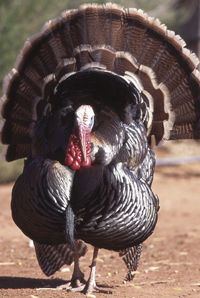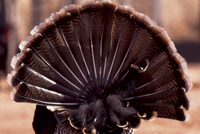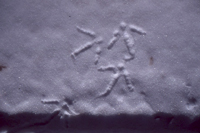Turkey Time |
|
To me November represents a lot of things: Scorpios, autumn leaves, crystalline night skies, high-flying skeins of geese, early morning frost, and turkey time. With autumn fading in the rearview mirror, November represents the transition time between the warmth of summer and the chill of winter. The turkey is the symbolic punctuation that defines this month, and its colorful past “gobbles” for recognition. Preparation for winter at Dead Horse Point State Park
With fall winding down, it’s time to begin preparations for winter here at Dead Horse Point State Park. Time to begin checking our snow removal equipment, turn the heaters on in the facilities and prepare the vehicles for colder temperatures. As humans, we have made it relatively easy to confront the coming winter weather. For all other life within the park, a decision to confront, migrate, hibernate, or expire must be made. For plant and animals that confront winter extremes, special adaptations are a must. Pinyon pines fill their stomata (the pores used for gas exchange) with waxy plugs and flush their needles with sugars to lower the freezing point, preventing cellular damage and avoiding death. Black-capped Chickadee emerges from a cavity in a tree trunk each day to search for larvae and pupae of insects buried in trees. It will cache as much food as possible during the day and will return later to reclaim these caches as needed. This small bird relies on it’s fat reserves and the ability to lower its temperature 10-12 0 C below its normal daytime temperature to endure the long winter nights.  Without the ability to sprout legs and migrate to another location, plants will sit this one out. Cool fall temperatures signal to the Ash-throated flycatcher that it is time to move farther south into Mexico and Central America. Moving south helps this spring-summer-fall resident of the park avoid the physical stress of confronting winter extremes. Without the ability to sprout legs and migrate to another location, plants will sit this one out. Cool fall temperatures signal to the Ash-throated flycatcher that it is time to move farther south into Mexico and Central America. Moving south helps this spring-summer-fall resident of the park avoid the physical stress of confronting winter extremes.With a chilly nip in the fall air, the long-nosed leopard lizard retreats to its burrow, well below the frost layer only to emerge with the warmth of spring’s arrival. This lizard will spend the winter months in hibernation, during which its body temperature will lower to just above freezing. It will gain the minimal energy needed from fat stored throughout its body. All bodily functions slow, reducing the need to intake food or export waste. Scarlet globemallow spent the last bits of summer storing as much energy in its root as possible. The leafy portion of the plant will die back during the winter leaving the roots to retain stored energy for spring growth. Throughout the winter months, this plant will be dormant waiting for the return of warmer temperatures before sending its first leaves above ground again. The most drastic response to approaching winter is to expire. Before the final day of a dwarf lupine’s life, as many seeds as energetically possible are sent out into the world. One last hurrah before death takes over with well wishes for a few to take root and emerge the next spring to carry on the tradition. For the hapless praying mantis that must meet it’s end, hopefully it had a full life filled with growth to an adult, mating and laying eggs to hatch the next spring. Understanding the colossal energy reserves needed to survive the cold winter months teaches me gratefulness for my heated home, warm clothing to get from place to place and access to stores for winter supplies. My time outside is spent skiing, snowshoeing or playing in the snow rather than rushing about providing for my daily, physical needs. Dead Horse Point State Park is located 32 miles from Moab, Utah at the end of Hwy 313. Visitor center hours are 9am-5pm. The park will be open on Thanksgiving Day, however the visitor center will be closed. For more information go to www.stateparks.utah.gov or call the park at (435) 259-2614. |

 The first domesticated turkeys in the southwest may have been penned up around 200 A.D. Archaeologists who study things like turkey coprolites (ancient poop) and midden piles loaded with turkey bones, believe the first domesticated turkeys were kept for their feathers which were used in rituals and ceremonies and for robes and blankets. Covered with over 5000 feathers, the birds provided a constant source. And based upon DNA samples, these domesticated birds may have been from a subspecies that ranged in Mexico and were brought north along with corn, beans and squash. These probably were not the local birds that were domesticated by a little crushed corn and scattered ricegrass seeds.
The first domesticated turkeys in the southwest may have been penned up around 200 A.D. Archaeologists who study things like turkey coprolites (ancient poop) and midden piles loaded with turkey bones, believe the first domesticated turkeys were kept for their feathers which were used in rituals and ceremonies and for robes and blankets. Covered with over 5000 feathers, the birds provided a constant source. And based upon DNA samples, these domesticated birds may have been from a subspecies that ranged in Mexico and were brought north along with corn, beans and squash. These probably were not the local birds that were domesticated by a little crushed corn and scattered ricegrass seeds.
 Ironically, it was Spanish conquistadors that hauled turkeys from Mexico back to Spain in the mid-16th century. The Aztecs had long domesticated the wild turkey prior to the appearance of the Europeans. Back in Europe, turkeys became a common barnyard fowl, so much so that when the Pilgrims settled in the New World they brought their domesticated fowl with them. Little did they realize that a larger, native species of turkey still roamed the New World’s woodlands.
Ironically, it was Spanish conquistadors that hauled turkeys from Mexico back to Spain in the mid-16th century. The Aztecs had long domesticated the wild turkey prior to the appearance of the Europeans. Back in Europe, turkeys became a common barnyard fowl, so much so that when the Pilgrims settled in the New World they brought their domesticated fowl with them. Little did they realize that a larger, native species of turkey still roamed the New World’s woodlands. 